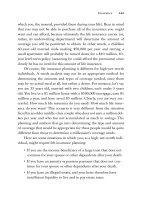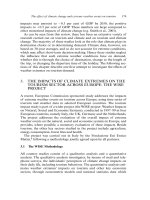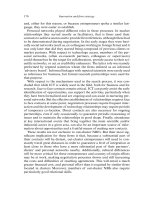101 activities foteaching creativity and problem solving phần 7 pptx
Bạn đang xem bản rút gọn của tài liệu. Xem và tải ngay bản đầy đủ của tài liệu tại đây (326.62 KB, 41 trang )
54
Chain Alike
Background
If you generate ideas using analogies, your source of stimulation is generally limited to
comparisons with the basic problem principle. For instance, the problem of preventing
shoplifting (the Bionic Ideas [53] illustration) is limited to analogies involving the princi-
ple of prevention. Although there is nothing wrong with this limitation, it does restrict the
number of possible problem perspectives. And that’s not good.
Fortunately, all is not lost. The Chain Alike activity attacks problems from multiple
perspectives. And that’s good.
Chain Alike is based on the Attribute Analogy Chains procedure developed by
Koberg and Bagnall (1976). Ideas are generated by listing problem attributes, developing
analogies for each attribute, and then using the analogies to prompt ideas.
Objectives
• To help participants generate as many creative ideas as possible
• To help participants learn how to use the activities to generate ideas
Participants
Small groups of four to seven people each
Materials, Supplies, and Equipment
• For each group: markers, two flip charts, and masking tape for posting flip-chart
sheets
• For each participant: one sheet each of three different colors of sticking dots
(
1
⁄2′′ diameter) and one pad of 4 x 6 Post-it
®
Notes
• (Optional) One paper or electronic thesaurus for each group
Handout
• Chain Alike Handout
234
101 Activities for Teaching Creativity and Problem Solving
08 VG 217-244b 10/5/04 5:00 PM Page 234
TLFeBOOK
Time
60 minutes
Related Activities
• Bionic Ideas [53]
• I Like It Like That [55]
Procedure
1. Distribute the handout, review it with the participants, and answer any questions
they may have.
2. Tape a sheet of flip-chart paper lengthwise on a wall or table.
3. Read the following instructions aloud:
“On the left side of the paper, list in a single column all major problem attributes (for example,
name, form, parts, shape, structure, processes, materials, functions). For each attribute, list several
subattributes that describe the attributes. Thus, ‘round’ and ‘square’ would be examples of two
types of shapes. Write these in a line to the right of each attribute.
“On a separate sheet of paper, write down several analogies or words similar in meaning for each
subattribute. The word ‘round,’ for example, might spark ‘circular,’ ‘a dog chasing its tail,’ and ‘a
rolling ball. You may use paper or electronic thesauri to help select these words.”
4. Tell them to examine each word analogy as a group, see what ideas are triggered,
write them on Post-it
®
Notes (one per note), and place them on flip-chart paper for
evaluation.
Debrief/Discussion
Chain Alike is slightly more complicated than other analogy-based activities. More work
is required to set up the stimuli to use as idea triggers. Ask the participants if they felt the
extra work was worth the effort and if the quality of ideas was any better than when com-
pared with other activities.
Also consider having participants debrief using the following questions:
• What was most helpful about this exercise?
• What was most challenging?
• What can we apply?
• How would you rate the value of this exercise to helping us with this issue?
• Will this exercise be helpful in the future for other sessions?
• What did you learn?
• What will we be able to use from this exercise?
• What ideas were generated, and which ones were most interesting?
235
Grab Bag: Miscellaneous Activities
08 VG 217-244b 10/5/04 5:00 PM Page 235
TLFeBOOK
Chain Alike Handout
Assume you are the manager of a department store. Your assistant has informed you that
the store’s losses due to shoplifting are greater than ever. To help resolve this problem,
you decide to try the Chain Alike activity.
• Customers
• Merchandise
• Money
• Security
• Observing customers
Next, list subattributes:
• Name: Shoplifting
• Customers: Children, elderly, middle-aged, rich, poor, educated, uneducated
• Merchandise: Electronics in display cases, clothing on shelves and racks
• Money: Dollar bills, coins, credit cards, debt, charging, exchange rates
• Security: Guards, cameras, alarms, lighting, electronic sensors
• Observing Customers: Watching, unobtrusive, disguises, equipment
Next, look at the subattributes and develop analogies for each one. For instance, some
sample word analogies might include the following:
• Name: Disappearing merchandise
• Customers: Small people, money collectors, enhanced brains
• Merchandise: Electronic organizers, viewing boxes, stacking levels
• Money: Circular disks, plastic debits, substituting values
• Security: Caretakers, visual image capturing devices, illumination projection
• Observing Customers: Hidden recesses, cover-ups, electronic information processors
Finally, generate ideas using these word analogies:
• Lock all merchandise in display cases (from “disappearing merchandise”).
• Install a system so that people must pay for merchandise on their way out to unlock
an exit door. People who don’t buy anything subject themselves to personal inspec-
tions (from “money collectors”).
• Place video cameras on merchandise counters (from “viewing boxes”).
• Provide educational seminars in schools on the pitfalls of shoplifting (from “substitut-
ing values”).
236
101 Activities for Teaching Creativity and Problem Solving
101 Activities for Teaching Creativity and Problem Solving. Copyright © 2005 by John Wiley &
Sons, Inc. Reproduced by permission of Pfeiffer, an Imprint of Wiley. www.pfeiffer.com
08 VG 217-244b 10/5/04 5:00 PM Page 236
TLFeBOOK
• Place monitors throughout the store that show shoplifters being arrested (from “visu-
al image capturing devices”).
• Project onto the walls pictures of previous customers who were caught shoplifting
(from “illumination projection”).
• Put all merchandise in vending machines (from “hidden recesses”).
237
Grab Bag: Miscellaneous Activities
101 Activities for Teaching Creativity and Problem Solving. Copyright © 2005 by John Wiley &
Sons, Inc. Reproduced by permission of Pfeiffer, an Imprint of Wiley. www.pfeiffer.com
08 VG 217-244b 10/5/04 5:00 PM Page 237
TLFeBOOK
55
I Like It Like That
Background
This activity is the grandparent of all the “just alike only different” activities. It is based
on general analogical thinking that relies on the direct comparison of one thing or action
to another. As with Bionic Ideas [53], comparisons are used to spark ideas. The difference
is that the comparisons may be drawn from anywhere, not just from Mother Nature, as
with Bionic Ideas. Once the similarities have been identified, they are elaborated and then
used to stimulate ideas.
Objectives
• To help participants generate as many creative ideas as possible
• To help participants learn how to use the activities to generate ideas
Participants
Small groups of four to seven people each
Materials, Supplies, and Equipment
• For each group: markers, two flip charts, and masking tape for posting flip-chart
sheets
• For each participant: one sheet each of three different colors of sticking dots
(
1
⁄2′′ diameter)and one pad of 4 x 6 Post-it
®
Notes
Handout
• I like It Like That Handout
Time
45 minutes
238
101 Activities for Teaching Creativity and Problem Solving
08 VG 217-244b 10/5/04 5:00 PM Page 238
TLFeBOOK
Related Activities
• Bionic Ideas [53]
• Chain Alike [54]
Procedure
1. Distribute the I Like It Like That Handout, review it with the participants, and
answer any questions they may have.
2. Tell group members to think of the major principle underlying their problem and
use it to generate a list of things similar to the problem. To help generate this list,
say, “This problem is like. . . .” (See the handout for an example.)
3. Instruct them to select one of the analogies and describe it in detail, elaborating as
much as possible, listing parts, functions, or uses. Remind them to include many
action-oriented phrases and, if possible, select an analogy that is controversial or
out of the ordinary.
4. Have them review each description and use it to stimulate ideas that they should
write on Post-it
®
Notes (one idea per note) and place on flip-chart paper for evalu-
ation.
Debrief/Discussion
Some research suggests that analogies are more likely than other direct stimulation activi-
ties to yield unique ideas. Analogies also seem to work especially well for mechanical
problems. For instance, analogies have been used to design a new type of thermos bottle
closure and a way to attach spacesuit helmets. Although this activity may take a little
more effort, it is quite useful for difficult problems.
Also consider having participants debrief using the following questions:
• What was most helpful about this exercise?
• What was most challenging?
• What can we apply?
• How would you rate the value of this exercise to helping us with this issue?
• Will this exercise be helpful in the future for other sessions?
• What did you learn?
• What will we be able to use from this exercise?
• What ideas were generated, and which ones were most interesting?
239
Grab Bag: Miscellaneous Activities
08 VG 217-244b 10/5/04 5:00 PM Page 239
TLFeBOOK
I Like It Like That Handout
Suppose you decide to use analogies to help recruit more engineers for your organization.
The major principle in this case is, “getting more of something.” Thus, you might think of
analogies prompted by the phrase, “This problem is like . . .”
• asking your parents for an increase in your allowance.
• asking your boss for a raise.
• asking a cook for more food.
• asking your boss for more time to complete a project.
• an employee trying to get more power over another employee.
• a football team trying to win more games.
• a panhandler begging for more money.
• calling people to sell more magazines.
Select one of these analogies and elaborate.
A panhandler begging for more money involves the following things:
• Deciding which people to ask
• Not being too overbearing
• Watching out for the police
• Looking pathetic
• Using creative requests, such as asking for a quarter to call about graduate school
admission
• Looking as presentable as possible
• Maintaining eye contact
• Finding the best location
• Using many different locations
Finally, use the elaborations to suggest ideas for recruiting engineers:
• Screen potential candidates using recommendations and background checks.
• Use a “soft sell” approach; don’t seem overly interested.
• Conduct security checks.
• Tell top recruits how much you need them.
• Give prospects a toll-free number to call if they have questions.
• Scout out the best recruiting locations.
• Search for a variety of personality and ability types by recruiting from many different
schools in various regions of the country.
240
101 Activities for Teaching Creativity and Problem Solving
101 Activities for Teaching Creativity and Problem Solving. Copyright © 2005 by John Wiley &
Sons, Inc. Reproduced by permission of Pfeiffer, an Imprint of Wiley. www.pfeiffer.com
08 VG 217-244b 10/5/04 5:00 PM Page 240
TLFeBOOK
56
What Is It?
Background
Advertising and marketing professionals frequently push products based on assumptions
regarding core motivations and needs. Rather than appeal to people to buy a product
based on its features, advertisers try to show potential customers how a product will sat-
isfy some need.
For instance, one advertisement might push a brand of coffee because it tastes good.
Another, in contrast, might emphasize how the product will satisfy the need to feel
secure. Because security may be a stronger motivator than the taste of coffee, consumers
may respond more positively to the need-satisfaction approach.
Here are some other possible examples:
• A convertible isn’t a car, it’s excitement.
• A watch isn’t a timepiece, it’s a piece of jewelry.
• A job position recruitment campaign isn’t for a job, it’s for prestige and recognition.
• A coat isn’t for warmth, it’s a fashion statement.
All of these relate to the question, What is it? Hall (1994) uses this question as the
basis for an idea generation method by the same name. It generates ideas by thinking
what else a problem is and then using these descriptions as idea stimuli.
Objectives
• To help participants generate as many creative ideas as possible
• To help participants learn how to use the activities to generate ideas
Participants
Small groups of four to seven people each
Materials, Supplies, and Equipment
• For each group: markers, two flip charts, and masking tape for posting flip-chart
sheets
• For each participant: one sheet each of three different colors of sticking dots
(
1
⁄2′′ diameter)and one pad of 4 x 6 Post-it
®
Notes
241
Grab Bag: Miscellaneous Activities
08 VG 217-244b 10/5/04 5:00 PM Page 241
TLFeBOOK
Handout
• What Is It? Handout
Time
45 minutes
Related Activities
• Essence of the Problem [38]
• Turn Around [52]
Procedure
1. Distribute the What Is It Handout, review it with the participants, and answer any
questions they may have.
2. Tell the participants to describe their problems in at least six different ways that
capture the “essence” of their problems (see the handout for examples).
3. Instruct them to use their descriptions to prompt ideas, write them on Post-it
®
Notes (one idea per note), and place them on a flip chart for evaluation.
Debrief/Discussion
This activity differs from most in its emphasis on human emotions and how they drive
our creative abilities. It can be especially useful for new product development because of
its ability to uncover consumer needs and supply ways to meet them. However, it also is
extremely versatile in its ability to provide diverse problem perspectives by helping
uncover hidden or unwarranted assumptions. You might ask participants to compare its
ability to generate unique ideas with a an activity that relies on unrelated stimuli such as
words, pictures, or objects.
Also consider having participants debrief using the following questions:
• What was most helpful about this exercise?
• What was most challenging?
• What can we apply?
• How would you rate the value of this exercise to helping us with this issue?
• Will this exercise be helpful in the future for other sessions?
• What did you learn?
• What will we be able to use from this exercise?
• What ideas were generated, and which ones were most interesting?
242
101 Activities for Teaching Creativity and Problem Solving
08 VG 217-244b 10/5/04 5:00 PM Page 242
TLFeBOOK
What Is It? Handout
Consider the problem of improving an office desk. First, describe what desks are. For
instance, you might say that office desks are not just desks, they are
• Smooth writing areas
• Occupational centers
• Computer support stands
• Leg and lap covers
• Hollowed-out wooden boxes
Then use these descriptions to generate ideas:
• A variable-tilt writing surface built into the desk top
• Desks tailored to different occupations. For instance, a doctor’s desk might have a
place to hold a stethoscope, a blood pressure cuff, and other diagnostic tools, as well
as a built-in computer screen with the Physician’s Desk Reference on a CD
• A computer monitor that flips up when needed, a CPU under the desk, and a key-
board built into the desk top
• A desk with heating pads and foot warmers
• A desk that can be collapsed easily and stored in a compact area
243
Grab Bag: Miscellaneous Activities
101 Activities for Teaching Creativity and Problem Solving. Copyright © 2005 by John Wiley &
Sons, Inc. Reproduced by permission of Pfeiffer, an Imprint of Wiley. www.pfeiffer.com
08 VG 217-244b 10/5/04 5:00 PM Page 243
TLFeBOOK
08 VG 217-244b 10/5/04 5:00 PM Page 244
TLFeBOOK
Group Only
Activities
L
L
09a VG Part III 245-246b 10/5/04 4:55 PM Page 235
TLFeBOOK
09a VG Part III 245-246b 10/5/04 4:55 PM Page 236
TLFeBOOK
Chapter 9
Brainstorming with
Related Stimuli
B
rainstorming with related activities is classic brainstorming as developed and popu-
larized by Alex Osborn. It’s idea generation that focuses on the problem and uses the
ideas of other group members as stimuli. The key to successful brainstorming is adher-
ence to the following brainstorming principles.
1. Defer Judgment
Withhold all evaluation of ideas during idea generation. That is, separate generation from
evaluation. Once you have listed all possible ideas, then go back and evaluate them.
There’s a lot of logic behind this principle. First, most groups don’t follow it and, as a
result, are less than productive. Second, deferring judgment increases the odds of finding
at least one good idea. If you spend a lot of time evaluating each idea as you think of it,
you may run out of time before you can list all possible ideas. It’s a matter of probability.
Finally, separating evaluation from generation helps you avoid creating a negative
group climate. Idea generation generally is a fun, positive experience. If you stop to criti-
cize each idea as it is proposed, you’re interjecting a negative process that disrupts the
more positive aspects. Thus, you may never produce a climate healthy enough for effec-
tive idea generation. Separate the processes and you’ll be amazed at how productive your
group can be.
2. Quantity Breeds Quality
The more ideas you list, the more high-quality ideas you’ll get. Again, it’s all a matter of
probability. Let’s assume there is a potential pool of five hundred ideas. That’s how many
ideas you could generate hypothetically if you had all the brains and time in the world.
Of these five hundred ideas, assume there are twenty-five you would consider as high
quality. If you use the sequential generate-evaluate, generate-evaluate-generate-evaluate
cycle, you may get “lucky” and produce a total of twenty-five ideas during a one-hour
brainstorming session. Now, just what are the odds that a majority of these would be the
LLLL
247
09 VG 247-294b 10/6/04 12:22 PM Page 247
TLFeBOOK
same twenty-five high-quality ideas? The answer: not very high. The sequential approach
relies on pure chance to produce a high-quality idea. It is more logical to increase the
odds by first listing as many ideas as possible. You always can go back and evaluate them
later. Moreover, each idea you list can help spark other ideas. So if you defer judgment
and shoot for quantity, you may produce 125 ideas. Now what are the odds that one of
those is a high-quality one? The answer: very high. You don’t need to be a statistician to
figure out this one.
3. The Wilder the Better
Although idea quantity is essential for idea quality, it may not always be sufficient. You
can’t always rely on the laws of probability. Thus, you need to free your mind and turn
off censors and shake off constraints. Shoot for wild, crazy, silly, off-the-wall ideas. These
ideas—and the ones they spark—are the ones you need for high-quality, winning ideas.
Don’t worry about practicality when generating ideas. Remember, you’re supposed to
separate generation and evaluation. Instead, focus on how many wild ideas you can think
of. Some conventional ideas are O.K., too. But don’t make a habit of it. Go for the unusual
and see what results.
4. Combine and Improve Ideas
Another way to ensure high-quality ideas is to not let your ideas get lonely. Give them
relatives and friends. That is, use your natural powers of free association and see how
you can combine an existing idea with another one to form a completely new idea. Or
encourage your ideas to be all they can be. Empower them to use their full potential. Take
an existing idea and try to improve it. How else might it be implemented? What could
you substitute, change, reverse, or make larger or smaller? What would make it better?
Go for it and you’ll increase your IQ (Idea Quotient) and generate better ideas as well.
NOTE:FOR ALL ACTIVITIES,REMIND PARTICIPANTS
TO DEFER JUDGMENT WHILE GENERATING IDEAS.
248
101 Activities for Teaching Creativity and Problem Solving
09 VG 247-294b 10/6/04 12:22 PM Page 248
TLFeBOOK
Related Activities
• Idea Links [41]
• Skybridging [46]
Procedure
1. Have the groups tape a sheet of flip-chart paper lengthwise on a wall or table.
2. Distribute the Be #1 Handout, review it with the participants, and answer any
questions they may have.
3. Tell the groups to list on the paper, in a single column, the current core benefits of
their general business category. Prompt them to include both the trivial and the
essential.
4. Have them create a second column in which they transform each benefit into its
best state. Have them use the phrase “the best” or a word that ends in “est” (for
example, “fastest”).
5. Direct them, in column three, to list ways to achieve this elevated status. Note that
these are their ideas.
6. Instruct them to repeat Steps 3 through 5, but to list in column one new benefits
that currently do not exist.
7. Tell them to write down any ideas on Post-it
®
Notes (one idea per note) and place
them on flip charts for evaluation.
Debrief/Discussion
An appealing feature of this exercise is that it may bring out a competitive spirit that can
be translated into creative applications. More importantly, the matrix structure of this
activity might provide the structure needed for some people to generate ideas instead of
having to “pull them out of the air.” It also provides a potentially useful visual focus for
group members to direct their attention. If participants have trouble generating ideas
with this exercise and time is available, consider having them start over but using new
benefits.
Also consider having participants debrief using the following questions:
• What was most helpful about this exercise?
• What was most challenging?
• What can we apply?
• How would you rate the value of this exercise to helping us with this issue?
• Will this exercise be helpful in the future for other sessions?
• What did you learn?
• What will we be able to use from this exercise?
• What ideas were generated, and which ones were most interesting?
250
101 Activities for Teaching Creativity and Problem Solving
09 VG 247-294b 10/6/04 12:22 PM Page 250
TLFeBOOK









